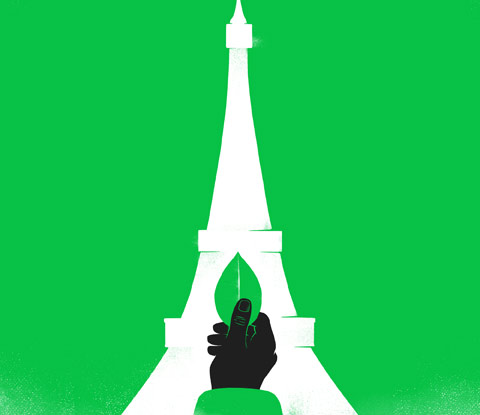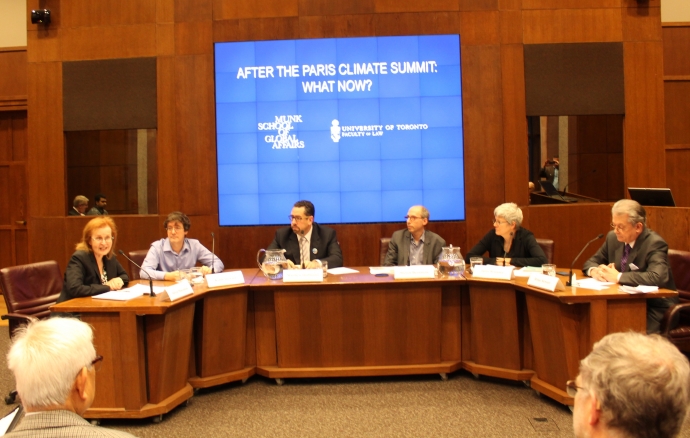A template to move forward: (left) Silvia Maciunas (Global Affairs), Keith Stewart (Greenpeace Canada), Matthew Hoffmann (Department of Political Science), Steven Bernstein (Department of Political Science), and Jutta Brunnée (Faculty of Law) with moderator Brian Stewart.
“This agreement is a shift to an adaptive or reflexive approach to global governance.” -- International Law scholar Jutta Brunnée
By Peter Boisseau
The Paris Agreement is an historic achievement, and its perceived flaws may turn out to be the secret to success after a long line of failed attempts at an effective climate deal, a panel of legal, political and environmental experts told a packed audience at an event organized by U of T’s Faculty of Law and the Munk School of Global Affairs.
While critics have dismissed the agreement as largely voluntary and lacking firm commitments, the panel’s assessment was those qualities simply reflect a new approach that is based on the hard lessons of past climate deals.
“This agreement is a shift to an adaptive or reflexive approach to global governance,” International Law scholar Jutta Brunnée said at the Dec. 6 panel, "After the Paris Climate Summit: What Now?". “We’ve left behind the idea we can deal with such a complex and rapidly changing problem with a rigid, formal top-down agreement.”
The Kyoto Protocol adopted in the late 1990s failed to curb emissions after setting greenhouse gas limits on only the wealthiest nations, and talks in Copenhagen in 2009 aimed at a new global deal were also a dismal failure.
The Paris Agreement was adopted by the consensus of 195 countries on December 12, 2015 at the 21st Conference of the Parties to the UN Climate Change Convention.
The agreement aims to limit global warming to “well below” 2 degrees Celsius, with an aspirational goal of 1.5 degrees C, and eventually bring down carbon emissions to net zero by the second half of the century.
Those goals are to be achieved by each country committing to Nationally Determined Contributions (NDCs) that represent their share of the global emissions reduction targets. All but a few of the 195 countries filed initial pledges toward their NDCs in Paris, representing about 96 per cent of global greenhouse emissions.
The agreement will take effect when 55 parties representing 55 per cent of total global greenhouse emissions have formally submitted their NDCs to the UN, likely around the middle of 2016.

Illustration by Sébastien Thibault
Countries will revisit their plans in 2018 and be legally required to renew them every five years starting in 2020, making them progressively more ambitious each time. They will also have to provide data on their emission reductions that will be verified by independent experts.
However, the targets themselves are not binding, “so that is the way that they squared the circle,” said Brunnée, who sought to put in perspective the criticisms that without legal enforcement, the NDC commitments amount to nothing meaningful.
“The shift from a top-down to a bottom-up agreement is significant because it deviates from the traditional model of international law, whereby you negotiate something binding at the international level then countries join and implement domestically,” said Brunnée.
“That model has been inverted, as the agreement envisions the parties first have a serious national conversation about what they can commit to, so that what they put forward internationally, though not binding, is likely to be more productive.”
Other panelists agreed the Paris Agreement may actually be a template for how to move forward on climate change without getting bogged down like previous attempts at a global deal.
“Environmentalists used to hope you’d get this grand international commitment, which would then force changes in domestic policy and everything would flow from that,”said Keith Stewart of Greenpeace Canada, who is also an instructor at the School for theEnvironment.
“It’s a logical model, but it’s not at all how politics actually works, and that was one of the big lessons from the utter failure of Copenhagen for social movements, that maybe we needed to change our thinking.”
The flexible approach of the Paris Agreement is an effective way to recognize countries have different needs and interests, said Silvia Maciunas, deputy director, oceans and environmental law division, Global Affairs Canada.
In 20 years of working on environmental issues, the Paris Agreement stands out for her because it finally gets everybody into the same tent, added Maciunas, who made it clear she was expressing her personal views and not those of the government.
“I think this agreement at least gets us all going in the right direction.”
Perhaps just as importantly, Paris seemed to signal a “paradigm shift” that recognized the beginning of the end for fossil fuels, some of the panelists suggested.
The groundwork for that “decarbonized economy” has already been laid over the last few years by environmentalists, social movements and even the business world, the U of T summit heard.
A year before the Paris Agreement, the U.S. and China signed a major climate pact to co-operate on reducing greenhouse gases and developing clean energy technology, and investments in renewable energy have driven down costs and made it competitive.
More money is now being invested in renewables in the electricity sector than in fossil fuels, noted Stewart, and U.S. coal companies have lost 90 per cent of their valuation. Just as tellingly, business lobbyists played a prominent role in Paris, anxious to be seen on the right side of history.
“I think the real value of Paris is that it brought us to where we already were,” said U of T political scientist Steven Bernstein, noting that sustainable development, poverty eradication and support for economic instruments like carbon markets also played a prominent role at these latest climate talks.
While some governments eventually made Kyoto a “bad word,” Bernstein said his sense is “things are different this time,” but the real test will be whether business leaders and the general public have truly shifted their understanding about what needs to be done.
Nobody on the panel at the U of T event was underestimating how big a challenge lies ahead, or how difficult it will be to keep the momentum from Paris going forward.
The looming U.S. presidential election in 2016 could see climate-change denying Republicans returned to power, playing havoc with any long-term action from that country. As well, other major players on climate emissions, such as India, have made it clear they will pursue cheap fossil fuel energy like coal unless they are given financial incentives to use clean energy instead.
The agreement’s target of 2 degrees C or even of 1.5 degrees C is also probably too optimistic given the current state of technology and lack of robust economic instruments, such as widespread carbon trading markets, the panelists also agreed.
The initial reduction plans put forth by countries so far come nowhere near those targets, they noted, and nations like Canada face enormous structural changes in their economies if they are to phase out fossil fuels.
But the world can pin some hope on the fact the deal is expected to get better over time as countries ratchet up their commitments and find new ways to cut emissions, and financial markets start to unlock the trillions of dollars needed for transformation.
The agreement allows countries to cooperate and pool their NDCs. In Canada, a number of provinces have already set up, or are moving toward, carbon trading markets with other jurisdictions such as California, so any national plan will at least be building on an existing foundation here, panelists noted.
Broad societal engagement and ongoing initiatives from industry, cities and NGOs also bodes well for keeping the momentum going into the future, said U of T political scientist Matthew Hoffmann.
“One of the things we actually don’t know yet is what a decarbonized future is going to look like,” said Hoffmann. What remains, he added, are electors to support politicians who are committed to mitigating climate change.
“We are now in a race to conceptualize the good life of a decarbonized world, and build the economic and political coalitions that will support it, so we get this in place before climate catastrophe.”
Photo: Adrienne Henry


